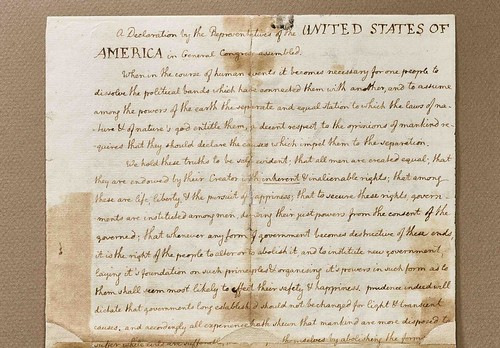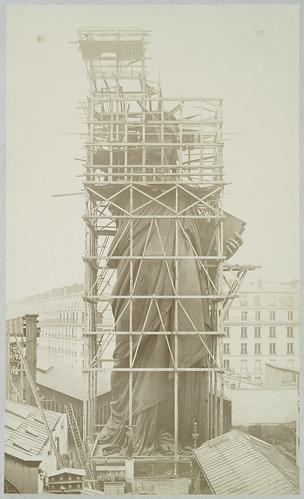If you want to choose an exhibition to break out of the difficulty and isolation that the Covid pandemic has produced for more than a year-and-a-half, how about one where you can see the original umbrella connected with Mary Poppins, a tablet of cuneiform characters from the 3rd to the 1st millennia BCA, and a letter that a freed black man wrote to purchase the freedom of his daughter in 1778? The New York Public Library’s Polonsky Exhibition, opened as a new permanent offering this fall, has this and more. In a word, it’s sure to engender wonder.
The exhibition’s objects span thousands of years of human history. The library has selected 250 rare items from its renowned research collection of some 56 million objects including rare books, prints, photographs, ephemera from pamphlets to flyers, letters, audio and moving images, household items, theatrical props, furnishings, and more. Each extraordinary object tells its own story, reflecting the intricacies of a turning point in history, a memorable cultural moment, a witnessing document or other object from a movement, or a time of great discovery, tragedy, or resilience. In this debut of the “Treasures,” the New York Public Library has organized the exhibition into nine sections: Beginnings, Performance, Explorations, Fortitude, The Written Word, The Visual World, Childhood, Belief, and New York City.
The exhibit is in the newly restored and renovated Gottesman Hall on the main floor of the Stephen A. Schwarzman Building at 42nd Street and Fifth Avenue. It is open to the public and free. Admission is by reserved, timed entry, through the New York Public Library’s site, nypl.org/treasures. The exhibition is the first-ever permanent exhibition spotlighting the library’s research collection. It is made possible by a $12 million gift from philanthropist Leonard Polonsky.
As New Yorkers welcome an active, thriving city after suffering through the Covid pandemic’s shutdowns for a good chunk of the past year-and-a-half and tourism returns bit by bit to New York, this exhibition is a thrilling addition. Still, many remain quite cautious about indoor public settings and travel. So it’s even more heartening that the thoughtfulness evident in the exhibition’s creation extends to a robust online experience (with images and text) and an Audio Guide focusing on a selection of objects.
The exhibit’s aim, in spanning 4,000 years of human history, is to build on the library’s legacy to make new connections that expand understanding of the world and each other, and, in doing so, to shape a better future.
Here are just some highlights on view in this first iteration of the Treasures exhibition. The exhibition will change and evolve over time, in its themes and selections, which will allow the public to experience the depth of the vast collection within the library’s research collections.

Photo: Robert Kato, New York Public Library
Thomas Jefferson’s Handwritten Copy of the Declaration of Independence. This is Jefferson’s handwritten copy of the Declaration of Independence, which scholars date between July 4 and July 10, 1776. His handwriting is small and neat on the paper, which is off-white and unruled.
This paper serves as a witness to how the history evolved. Congress debated and revised Jefferson’s original draft. He wrote out this version afterward and underlined when Congress made changes. In this version, Jefferson had written a denouncement of the slave trade in strong terms, calling it a “cruel war against human nature,” and on “assemblage of horrors.” Yet Jefferson was an enslaver who owned more than 600 human beings throughout his life. The Congress excised the denunciation of the slave trade in the Declaration’s final version.
In the audio guide, Anna Deavere Smith observes, “…Jefferson’s omitted passage allows us a solemn opportunity to imagine how history might have been different if, from the beginning, the United States had taken a stand against the evils of enslavement.”

Photo: New York Public Library
Bill of Sale to a Freed Black Man, 1778. To read a textbook summary of slavery is one thing. To see a weathered document of 1778 – a Bill of Sale in which a freed black man purchased the freedom of his daughter – is something tangible and powerful. It is firsthand documentation of slavery’s horrible dehumanization, and the actions black people undertook to gain freedom when possible.
The Bill of Sale names the free black man, Adam, who provided sixpence to a woman so that he could purchase freedom for his daughter, Jenny. The enslaver was Isabella Kearney, who signed this document, dated Oct. 19, 1778, in New York State. Two witnesses also signed this contract.
The document exemplifies a father’s care. It’s concrete proof of how slavery broke apart families in that Adam had no existing legal right of fatherhood until purchasing his daughter’s freedom. The archives of slavery often do not capture the interior lives of enslaved people, explains Michelle Commander, curator of the Lapidus Center for the Historical Analysis of Transatlantic Slavery as the Schomberg Center, in the exhibit’s audio guide. So, as Commander says, we have “to infer from the documents” such as this one: “Of course it’s very heartbreaking that we have a father who has to purchase his daughter’s freedom.” This sparks questions and some speculation: What might this document have meant to the father and daughter? What kind of protection did it offer? Where might Adam and Jenny gone after he purchased her freedom?

Photo: New York Public Library, Robert Kato
Umbrella Belonging to Mary Poppins Author P.L. Travers. In the Treasures exhibit, you can see an author’s possession that became an inspiration for an object with extraordinary powers – P.L. Travers’ umbrella. In her classic storybook series based on a quirky, prickly, and beloved nanny, Travers employed a fanciful parrot-head umbrella that Mary Poppins used to great effect. It had incredible powers, becoming a parachute that transported Poppins up and away, off into the sky.
Pamela Lyndon Travers, born in Australia as Helen Lyndon Goff, loved fairy tales from her earliest days. She also admired a parrot-headed umbrella that a family maid carried and saved to buy one of her own. A writer of articles, travel stories, and poems, she subsequently created the stories of a magical nanny who carried a parrot-head umbrella with amazing powers. In May 1972, Travers’ American editor gave this umbrella to the New York Public Library. At the time, Travers donated a collection of artifacts that were associated with her storybook series to the New York Public Library. It is quite a back story.

Photo: New York Public Library, Robert Kato
Cuneiform tablets. The library possesses some 700 artifacts inscribed in the ancient writing system known as cuneiform. The script was invented in the middle of the 4th millennium BCE in the region of Mesopotamia, in what is present-day Iraq. Students of cuneiform learned up to 1,000 different characters, which a person inscribed into damp clay using styli made of reed or bone.

Photo: New York Public Library
Ptolemy’s Geographia. A richly illustrated 15th century manuscript copy renders the work of Claudius Ptolemy, the 2nd century geographer, astronomer, mathematician, astrologer, and cosmographer. It captures the cosmological beliefs of the Roman era, which remained strong in the 15th century.

Photo: New York Public Library
Ida B. Wells, A Red Record, Tabulated Statistics and Alleged Causes of Lynchings in the United States, 1892-1893-1894. The exhibit has an original copy of Ida B. Wells’ Red Record. In the letter to investigative journalist Ida B. Wells for the Red Record that became its preface, Frederick Douglass wrote, “Let me give you thanks for your faithful paper on the lynch abomination….” Indeed, Wells (later Wells-Barnett) launched a crusade against lynching in the late 19th century. Following on her trailblazing pamphlet, Southern Horrors: Lynch Law in All Phases, Wells used white mainstream newspapers to produce a meticulously documented exposé on lynching. Wells found that white mob violence resulted in the killings of more than 10,000 African Americans in the South between 1864 and 1894.

Photo: New York Public Library
Photograph of the Statue of Liberty Under Construction in France. Whether you see it from land, sky, water, or up-close, the Statue of Liberty inspires awe. Its history is even more amazing when you see a photograph that records the French building it in Paris before taking it apart piece by piece and shipping Lady Liberty to the United States. Frédéric-Auguste Bartholdi conceptualized and designed the copper sculpture while Gustave Eiffel’s skeletal structural system incorporated a massive central iron pylon to stabilize Lady Liberty.
French photographer Albert Fernique took many photos of the Statue of Liberty while it was under construction. The exhibition includes one of the 13 the New York Public Library owns, an 1883 albumen print. Though the photograph shows the statue surrounded by scaffolding, its magnificence is still evident as is its colossal scale compared to the Parisian buildings in the background. It’s mind-blowing to consider not only the original construction but also the accomplishment of taking it apart to transport for its voyage to the U.S.
It’s impossible to choose just a selection of objects and convey the full depth of the Treasures exhibition. Surely, varied items, artworks, and documents will speak powerfully to different individuals, whether it be the 17th century Megillah: Scroll of the Book of Esther; Charlotte Brontë’s travel writing desk; the earliest issued New York City money from 1708; the first printed version of Mother Goose; the script for the pre-Broadway production of A Streetcar Named Desire, and much more. I look forward to scheduling my first visit and can imagine that taking in this exhibition will require repeat visits.
Exhibition Details: In Person and Online
For those who want to see the Treasures exhibition, the New York Public Library offers information to plan your visit and reserve timed tickets. Visitors can access an Audio Tour on a laptop or one’s smartphone: an English or a Spanish version, or an accessible version with verbal descriptions. If you are not planning to visit in New York, one can construct a very rich virtual visit through the online version that captures the exhibition’s themes and content.



No Comments so far ↓
There are no comments yet...Kick things off by filling out the form below.